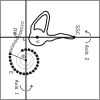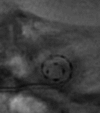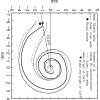Consensus panel on a cochlear coordinate system applicable in histologic, physiologic, and radiologic studies of the human cochlea
- PMID: 20147866
- PMCID: PMC2945386
- DOI: 10.1097/MAO.0b013e3181d279e0
Consensus panel on a cochlear coordinate system applicable in histologic, physiologic, and radiologic studies of the human cochlea
Abstract
Hypothesis: An objective cochlear framework, for evaluation of the cochlear anatomy and description of the position of an implanted cochlear implant electrode, would allow the direct comparison of measures performed within the various subdisciplines involved in cochlear implant research.
Background: Research on the human cochlear anatomy in relation to tonotopy and cochlear implantation is conducted by specialists from numerous disciplines such as histologists, surgeons, physicists, engineers, audiologists, and radiologists. To allow accurate comparisons between and combinations of previous and forthcoming scientific and clinical studies, cochlear structures and electrode positions must be specified in a consistent manner.
Methods: Researchers with backgrounds in the various fields of inner ear research as well as representatives of the different manufacturers of cochlear implants (Advanced Bionics Corp., Med-El, Cochlear Corp.) were involved in consensus meetings held in Dallas, March 2005, and Asilomar, August 2005. Existing coordinate systems were evaluated, and requisites for an objective cochlear framework were discussed.
Results: The consensus panel agreed upon a 3-dimensional, cylindrical coordinate system of the cochlea using the "Cochlear View" as a basis and choosing a z axis through the modiolus. The zero reference angle was chosen at the center of the round window, which has a close relationship to the basal end of the Organ of Corti.
Conclusion: Consensus was reached on an objective cochlear framework, allowing the outcomes of studies from different fields of research to be compared directly.
Figures









References
-
- Greenwood DD. A cochlear frequency-position function for several species--29 years later. J Acoust Soc Am. 1990;87:2592–2605. - PubMed
-
- Greenwood DD. Critical bandwidth and consonance in relation to cochlear frequency-position coordinates. Hear Res. 1991;54:164–208. - PubMed
-
- Greenwood D. Critical Bandwidth and Frequency Coordinates of Basilar Membrane. Journal of the Acoustical Society of America. 1961;33:1344.
-
- Blamey PJ, Dooley GJ, Parisi ES, Clark GM. Pitch comparisons of acoustically and electrically evoked auditory sensations. Hearing Research. 1996;99:139–150. - PubMed
-
- Tong YC, Clark GM. Absolute Identification of Electric Pulse Rates and Electrode Positions by Cochlear Implant Patients. Journal of the Acoustical Society of America. 1985;77:1881–1888. - PubMed
Publication types
MeSH terms
Grants and funding
LinkOut - more resources
Full Text Sources
Other Literature Sources

